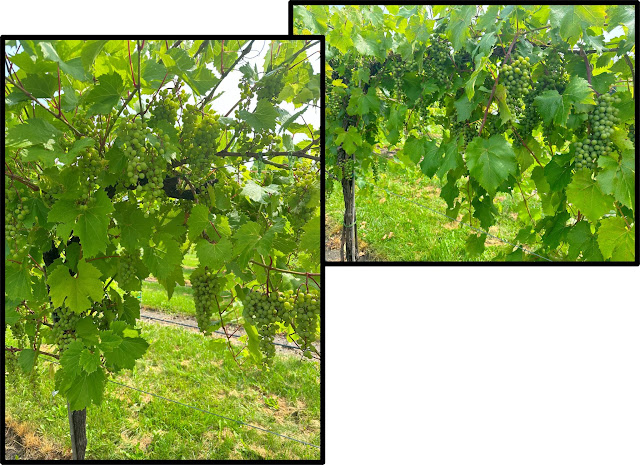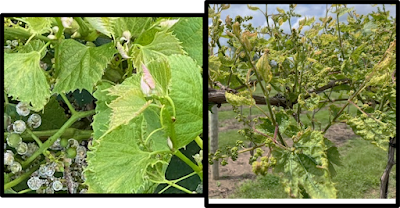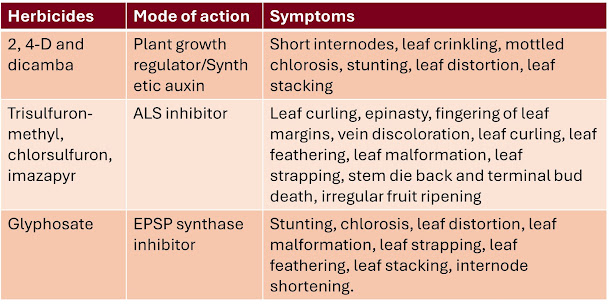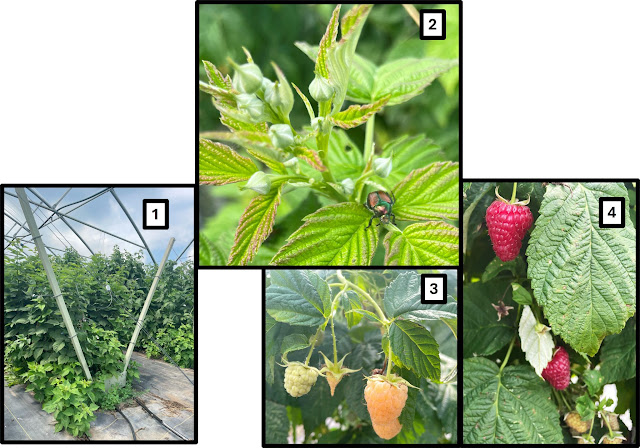Madeline Wimmer- UMN Fruit Production Extension Educator
This fruit update contains information about…

What constitutes a cider apple?
How cider apples are classified is somewhat subjective based on the goals of a cider maker. Some traditional cider apple cultivars originate from regions historically known for their cider production, such as the United Kingdom and France. But what makes apples like Dabinette or Ellis Bitter different from something like a Honeycrisp apple? Apples that have been bred and selected for fresh eating and processing usually offer some combination of sweet and tart flavors, but often lack the tannin compounds that contribute to bitter flavors and mouthfeel. This gives way to the way cider apples are classified by taste perception: bitter, sweet, sharp (i.e., acidic), or a combination of the former traits. Because what makes a “good” cider is subjective, some cider makers actually prefer to use fresh eating apples that offer enough sharpness to create a quality beverage that is still favorable to consumers. Whichever type of apple is used for cider production, the spectrum of flavors and tasting experiences can offer a unique and refreshing market for the Upper Midwest.

This fruit update contains information about…
- Apples- cider apple production.
- Grapes- growth stage updates and herbicide damage on grapes.
- Raspberries- growth stage updates. 2024 Japanese beetle trends and research updates.
Apples
Images: A small capture of the diverse number of apple cultivars used for cider production at Keepsake Cidery’s orchard, including Centennial Crabapple (upper left), Ellis Bitter (upper right), and Foxwhelp (lower left), located near Northfield, Minnesota (Zone 5a).
What constitutes a cider apple?
How cider apples are classified is somewhat subjective based on the goals of a cider maker. Some traditional cider apple cultivars originate from regions historically known for their cider production, such as the United Kingdom and France. But what makes apples like Dabinette or Ellis Bitter different from something like a Honeycrisp apple? Apples that have been bred and selected for fresh eating and processing usually offer some combination of sweet and tart flavors, but often lack the tannin compounds that contribute to bitter flavors and mouthfeel. This gives way to the way cider apples are classified by taste perception: bitter, sweet, sharp (i.e., acidic), or a combination of the former traits. Because what makes a “good” cider is subjective, some cider makers actually prefer to use fresh eating apples that offer enough sharpness to create a quality beverage that is still favorable to consumers. Whichever type of apple is used for cider production, the spectrum of flavors and tasting experiences can offer a unique and refreshing market for the Upper Midwest.
Infographic: A Ven diagram displaying the various flavor compositions that create cider apple classifications: Sweet, sharp, bitter, bittersweet, and bittersharp. These attributes contribute to taste perceptions, mouthfeel, and affect the overall fermentation process.
Cider apple production
Some traditional cider apple cultivars present challenges for Minnesota growers as they are marginally hardy in many Upper Midwest regions. Additionally, some cultivars bear biennially, and are tip-bearing, rather than spur-bearing, which changes how the trees are managed, including how they are pruned. Overall, cider apple production has similar requirements to fresh eating apple production, with more tolerance of minor blemishes on the fruit.
There is debate around whether or not cider apples should be harvested from orchard grounds that are hypothetically free from manure contamination. Despite fermentation being a “kill step” the concern is contamination of patulin, a mycotoxin produced by fungal pathogens for which the legal limit for cider set by the United State FDA is 50µg/L. Currently, ground harvesting of cider apples is practiced in the United Kingdom where the harvest and transportation process is highly mechanized for some orchards. This mechanization involves shaking trees to encourage fruit drop, followed by windrowing, or the raking and then collection of apples into bins before they are transported for processing. Cornell University has recently explored some research on ground harvesting cider apples as well. Knowing that there will always potentially be some amount of risk for patulin introduction with ground harvesting, sharing about this management approach is for educational purposes more than encouraging its adoption.

Grapes have been in Stage II of berry ripening, in which berries have expanded in size and are beginning to lose chlorophyll, but are still firm. Soon, grapes will be entering veraison, the period in which grapes begin to Stage III of ripening. This is visually identified by color change, especially in red, or darker colored berry cultivars. After veraison, grapes will continue to soften, reduce their acidity, increase sugar content, and develop flavors and aromas.
Herbicide damage

Grapes are very sensitive to herbicide drift and show more dramatic symptoms than other crops. Experiencing drift—whether it originates from within or outside of a vineyard—can be frustrating and challenging for growers. While resources like DriftWatch can provide some help in putting vineyards on the map, it still takes a communal approach to ensuring good herbicide practices in surrounding areas to prevent drift from entering vineyards. Having sufficient communication with neighboring farms and county highway departments can help ensure more transparency in regards to out-of-vineyard spray applications.
Growers who have detected drift in Minnesota always have the option to immediately report their findings to the Minnesota Department of Agriculture (MDA) to open an investigation, which can have its own complications and may not fully address the bigger picture of herbicide drift. To learn more about filing a drift complaint to the MDA, look at their web page, “Pesticide drift complaint process and timeline.” Additional steps to prevent herbicide drift include selecting growing sites that are not adjacent to row crop fields—which may be possible for new growers—or planting a buffer strip of trees on vineyard edges with neighboring row crop fields.
To prevent injury from on-site herbicide applications, growers should be careful about which herbicides are applied at any given time of the year. Certain herbicides should only be applied in vineyard blocks with mature grapevines, as they can injure younger grapevines with less woody growth. Some herbicides are systemic, whereas other herbicides are more local and can actually be used for managing grapevine suckers— the shoots that emerge from the grapevine base. To learn more about ground and weed management for grape production, view Growing grapes in Minnesota: Chapter 10.
What do herbicide damage symptoms look like?
Herbicide symptoms can vary depending on which type of herbicide is involved. Additionally, the amount, concentration, droplet form (i.e., particle vs vapor), and weather conditions at the time of drift also contribute to resulting symptoms. Some herbicides are formulated using the plant growth regulator (PGR) auxin, which include 2,4-D and dicamba, as well as picloram, triclopyr, and clopyralid. Inhibition of acetolactate synthase (ALS) is a different mode of action in herbicides trisulfuron-methyl, imazapyr, and chlorsulfuron, of which grapes are also sensitive. Glyphosate is a well-known herbicide that can cause injury in grapes and works by inhibiting EPSP synthase, an enzyme that plays a key role in creating plant proteins and other biochemicals. While symptoms can vary within different herbicide categories, some trends exist, which can be referenced in the chart below.
 *This table was created from information sourced from University of California IPM.
*This table was created from information sourced from University of California IPM.
Herbicide injury vocabulary
To view a gallery of herbicide drift symptoms, visit the University of California IPM’s Herbicide symptoms search engine.

Images: (1) Fall-bearing raspberries do well with a simple trellis to keep the primocanes off the ground. (2) Japanese beetles can damage raspberry foliage and fruits. Fall-bearing raspberries come in a range of colors including golden (3), peach, and various shades of red (4). Photos taken at Little HIll Berry Farm, near Northfield, MN (Zone 5a).
Growers producing fall-bearing raspberries are at the beginning stages of harvest in some parts of Minnesota. Fall-bearing raspberries can be grown outside or in a high tunnel as shown in picture one, above. Using a simple trellis provides guidance for raspberry canes and prevents them from laying on the ground. This can decrease the chance of fruit rot and other issues that occur when fruits contact the ground, and is especially helpful for fruit quality because of the challenges presented with washing raspberries.
How do fall-bearing and summer-bearing raspberries differ?
Fall-bearing raspberries differ from summer-bearing raspberries in that they develop fruits on shoots that emerge from the ground during that same growing season, known as primocanes. In contrast, summer-bearing raspberries set fruiting buds during the growing season on primocanes and then blooms and forms fruit the following season on those aged canes, referred to as floricanes. In other words, a floricane is a one-year-old primocane.
Japanese beetles and raspberries
Many fruit crops are subject to Japanese beetle foliar damage, but raspberries are one fruit crop that additionally is vulnerable to damage on its soft-fleshed berries. Japanese beetles are important to manage early on because of their attraction to organic volatile compounds (OVC) released from beetles chewing on plants as well as beetle sex pheromones from mating. As more beetles gather together, the signal becomes stronger.
2024 Japanese beetle trends and research update
This year, researchers at the University of Minnesota (UMN) have described low-to-moderate Japanese beetle numbers compared to recent years before drought conditions occurred. Dry conditions likely impacted Japanese beetle populations negatively because the female adults prefer to lay their eggs in moist soils underneath managed turf between raspberry rows, and other environments (e.g., vineyards and other managed turf grasses). Thus, in dry, coarse-textured soils where egg laying occurred, very few larvae (i.e., white grubs) survived the winter leading to a smaller initial population the following spring. There is also the question of grub survivability and their ability to successfully pupate with the increased rainfall that occurred this spring and earlier on in the summer.
Previous UMN research established action thresholds for Japanese beetles as 15-20 adults per meter, or yard within a row, and research from the 2024 growing season continues to support a threshold of under 20 adults or fewer per yard*. On average, only a 10-12 yard-row samples are required to take a representative sample for this scouting protocol, and nearly 80% of beetles can be located in the top third of the canopy, which is where samples should be collected. Researchers have additionally observed that high-tunnels present an added level of protection, which could result from the shading or increases in afternoon heat associated with high-tunnel production.
UMN researchers are additionally excited about the continued spread and impact that the winsome fly has had on Japanese beetle populations, noting an average of 25-30% parasitism on Japanese beetle adults. With the help of citizens taking the winsome fly survey, we now have documented its spread to 9 more Minnesota counties. This is positive news!
*It should be noted that younger plants will usually require a lower action threshold due to their inability to tolerate defoliation. Additionally, UMN researchers recommend growers take note of the “edge effect,” where Japanese beetles tend to limit their feeding initially to row edges.
The University of Minnesota Extension fruit production program would like to extend a thank-you to our fruit grower partners who make these reports possible.
Non-credited photos in these publications were taken by the author, Madeline Kay Wimmer, M.S.
Some traditional cider apple cultivars present challenges for Minnesota growers as they are marginally hardy in many Upper Midwest regions. Additionally, some cultivars bear biennially, and are tip-bearing, rather than spur-bearing, which changes how the trees are managed, including how they are pruned. Overall, cider apple production has similar requirements to fresh eating apple production, with more tolerance of minor blemishes on the fruit.
There is debate around whether or not cider apples should be harvested from orchard grounds that are hypothetically free from manure contamination. Despite fermentation being a “kill step” the concern is contamination of patulin, a mycotoxin produced by fungal pathogens for which the legal limit for cider set by the United State FDA is 50µg/L. Currently, ground harvesting of cider apples is practiced in the United Kingdom where the harvest and transportation process is highly mechanized for some orchards. This mechanization involves shaking trees to encourage fruit drop, followed by windrowing, or the raking and then collection of apples into bins before they are transported for processing. Cornell University has recently explored some research on ground harvesting cider apples as well. Knowing that there will always potentially be some amount of risk for patulin introduction with ground harvesting, sharing about this management approach is for educational purposes more than encouraging its adoption.
Grapes
Growth stageImage: As of July 23rd, Frontenac (lower left) and La Crescent (upper right) grapes are still in a pre-veraison state, exhibiting larger berries that are firm and green. Photos taken at the University of Minnesota Horticulture Research Station (UMN HRC; Zone 5a).
Grapes have been in Stage II of berry ripening, in which berries have expanded in size and are beginning to lose chlorophyll, but are still firm. Soon, grapes will be entering veraison, the period in which grapes begin to Stage III of ripening. This is visually identified by color change, especially in red, or darker colored berry cultivars. After veraison, grapes will continue to soften, reduce their acidity, increase sugar content, and develop flavors and aromas.
Herbicide damage
Images: Different herbicides lead to a range of symptoms in grapes including the fanning displayed on the left and shoe-stringing— a condition with the appearance of fabric puckering, or a tightened cupped look as seen on the right photo (left photo credited to a Minnesota grower from Morrison County and right photo from a grower located in Washington County).
Grapes are very sensitive to herbicide drift and show more dramatic symptoms than other crops. Experiencing drift—whether it originates from within or outside of a vineyard—can be frustrating and challenging for growers. While resources like DriftWatch can provide some help in putting vineyards on the map, it still takes a communal approach to ensuring good herbicide practices in surrounding areas to prevent drift from entering vineyards. Having sufficient communication with neighboring farms and county highway departments can help ensure more transparency in regards to out-of-vineyard spray applications.
Growers who have detected drift in Minnesota always have the option to immediately report their findings to the Minnesota Department of Agriculture (MDA) to open an investigation, which can have its own complications and may not fully address the bigger picture of herbicide drift. To learn more about filing a drift complaint to the MDA, look at their web page, “Pesticide drift complaint process and timeline.” Additional steps to prevent herbicide drift include selecting growing sites that are not adjacent to row crop fields—which may be possible for new growers—or planting a buffer strip of trees on vineyard edges with neighboring row crop fields.
To prevent injury from on-site herbicide applications, growers should be careful about which herbicides are applied at any given time of the year. Certain herbicides should only be applied in vineyard blocks with mature grapevines, as they can injure younger grapevines with less woody growth. Some herbicides are systemic, whereas other herbicides are more local and can actually be used for managing grapevine suckers— the shoots that emerge from the grapevine base. To learn more about ground and weed management for grape production, view Growing grapes in Minnesota: Chapter 10.
What do herbicide damage symptoms look like?
Herbicide symptoms can vary depending on which type of herbicide is involved. Additionally, the amount, concentration, droplet form (i.e., particle vs vapor), and weather conditions at the time of drift also contribute to resulting symptoms. Some herbicides are formulated using the plant growth regulator (PGR) auxin, which include 2,4-D and dicamba, as well as picloram, triclopyr, and clopyralid. Inhibition of acetolactate synthase (ALS) is a different mode of action in herbicides trisulfuron-methyl, imazapyr, and chlorsulfuron, of which grapes are also sensitive. Glyphosate is a well-known herbicide that can cause injury in grapes and works by inhibiting EPSP synthase, an enzyme that plays a key role in creating plant proteins and other biochemicals. While symptoms can vary within different herbicide categories, some trends exist, which can be referenced in the chart below.
Herbicides, modes of actions, and symptoms as they show up on grapes*
Herbicide injury vocabulary
- Chlorosis: a pale or yellow leaf color due to a lack of chlorophyll.
- Epinasty: when leaves have a downward bending appearance due to the upper leaf growing faster than the bottom side.
- Leaf feathering: abnormal growth on leaf edges that cause a feathered appearance on leaf margins.
- Leaf strapping: an unusual, stretched-look to a leaf, relative to its width.
- Leaf stacking: when leaves growth unusually close to a stem due to shortened internodes, making the foliage look compressed.
- Mottled chlorosis: parts of a leaf appear chlorotic while other parts look normal.
- Shoe-stringing: distorted leaf appearance that looks both elongated and cupped, almost like the fabric puckering that can happen when a thread’s tension is too tight within a piece of fabric.
To view a gallery of herbicide drift symptoms, visit the University of California IPM’s Herbicide symptoms search engine.
Fall-bearing raspberries
Images: (1) Fall-bearing raspberries do well with a simple trellis to keep the primocanes off the ground. (2) Japanese beetles can damage raspberry foliage and fruits. Fall-bearing raspberries come in a range of colors including golden (3), peach, and various shades of red (4). Photos taken at Little HIll Berry Farm, near Northfield, MN (Zone 5a).
Growers producing fall-bearing raspberries are at the beginning stages of harvest in some parts of Minnesota. Fall-bearing raspberries can be grown outside or in a high tunnel as shown in picture one, above. Using a simple trellis provides guidance for raspberry canes and prevents them from laying on the ground. This can decrease the chance of fruit rot and other issues that occur when fruits contact the ground, and is especially helpful for fruit quality because of the challenges presented with washing raspberries.
How do fall-bearing and summer-bearing raspberries differ?
Fall-bearing raspberries differ from summer-bearing raspberries in that they develop fruits on shoots that emerge from the ground during that same growing season, known as primocanes. In contrast, summer-bearing raspberries set fruiting buds during the growing season on primocanes and then blooms and forms fruit the following season on those aged canes, referred to as floricanes. In other words, a floricane is a one-year-old primocane.
Japanese beetles and raspberries
Many fruit crops are subject to Japanese beetle foliar damage, but raspberries are one fruit crop that additionally is vulnerable to damage on its soft-fleshed berries. Japanese beetles are important to manage early on because of their attraction to organic volatile compounds (OVC) released from beetles chewing on plants as well as beetle sex pheromones from mating. As more beetles gather together, the signal becomes stronger.
2024 Japanese beetle trends and research update
This year, researchers at the University of Minnesota (UMN) have described low-to-moderate Japanese beetle numbers compared to recent years before drought conditions occurred. Dry conditions likely impacted Japanese beetle populations negatively because the female adults prefer to lay their eggs in moist soils underneath managed turf between raspberry rows, and other environments (e.g., vineyards and other managed turf grasses). Thus, in dry, coarse-textured soils where egg laying occurred, very few larvae (i.e., white grubs) survived the winter leading to a smaller initial population the following spring. There is also the question of grub survivability and their ability to successfully pupate with the increased rainfall that occurred this spring and earlier on in the summer.
Previous UMN research established action thresholds for Japanese beetles as 15-20 adults per meter, or yard within a row, and research from the 2024 growing season continues to support a threshold of under 20 adults or fewer per yard*. On average, only a 10-12 yard-row samples are required to take a representative sample for this scouting protocol, and nearly 80% of beetles can be located in the top third of the canopy, which is where samples should be collected. Researchers have additionally observed that high-tunnels present an added level of protection, which could result from the shading or increases in afternoon heat associated with high-tunnel production.
UMN researchers are additionally excited about the continued spread and impact that the winsome fly has had on Japanese beetle populations, noting an average of 25-30% parasitism on Japanese beetle adults. With the help of citizens taking the winsome fly survey, we now have documented its spread to 9 more Minnesota counties. This is positive news!
*It should be noted that younger plants will usually require a lower action threshold due to their inability to tolerate defoliation. Additionally, UMN researchers recommend growers take note of the “edge effect,” where Japanese beetles tend to limit their feeding initially to row edges.
Thank you to the Hutchinson lab for contributing information about the UMN 2024 Japanese beetle update.
❖❖❖❖❖❖❖❖❖❖❖❖❖❖❖❖❖❖❖❖❖❖❖❖❖❖❖❖❖❖❖❖❖❖❖❖❖❖❖❖❖❖❖❖❖❖The University of Minnesota Extension fruit production program would like to extend a thank-you to our fruit grower partners who make these reports possible.
Non-credited photos in these publications were taken by the author, Madeline Kay Wimmer, M.S.
Comments
Post a Comment